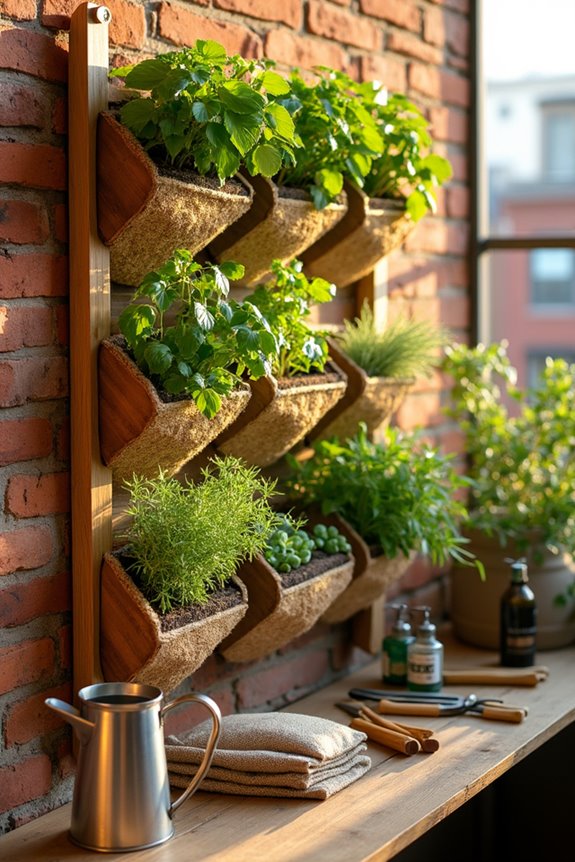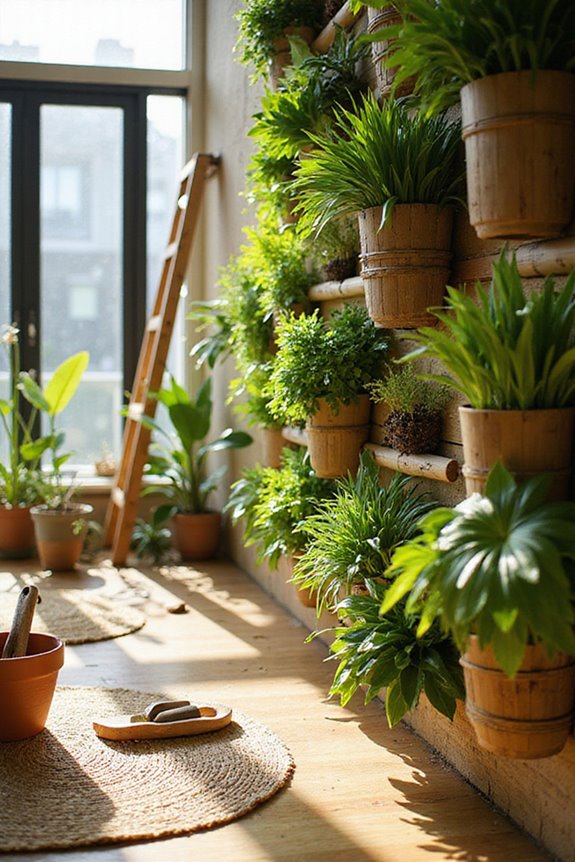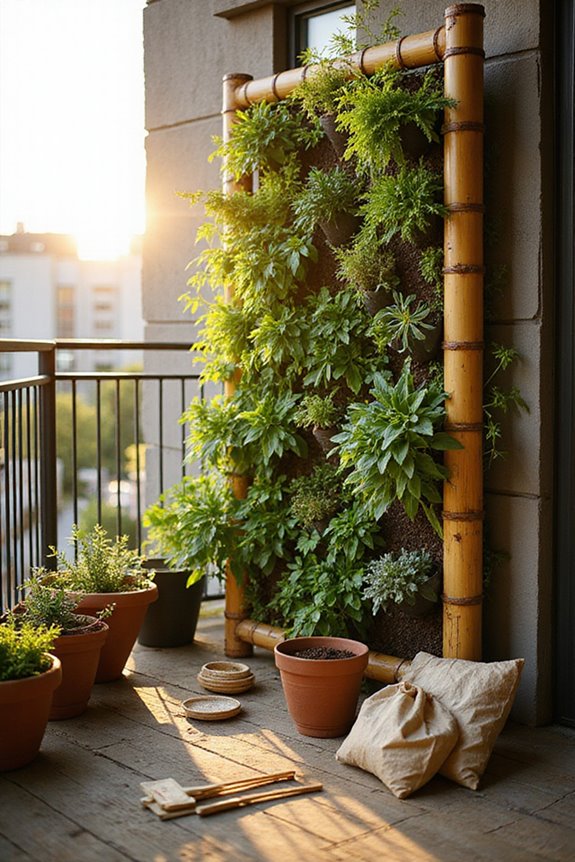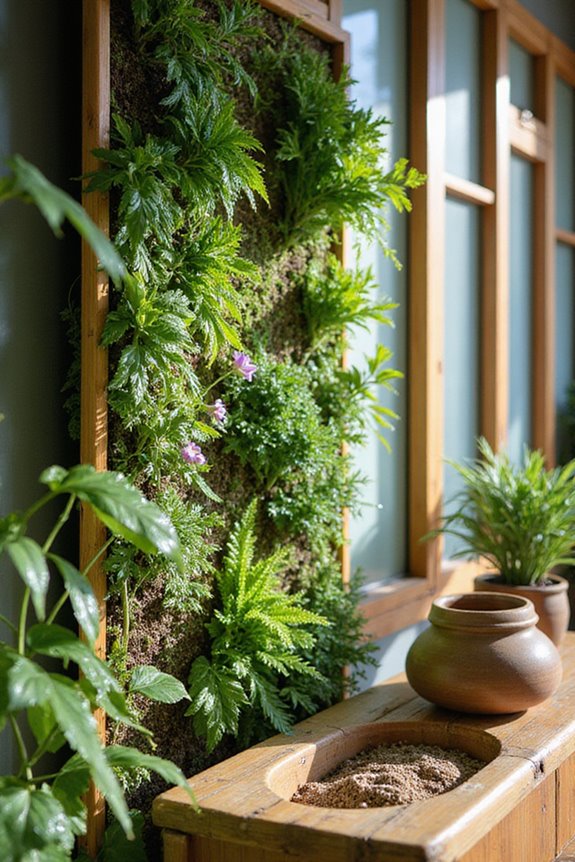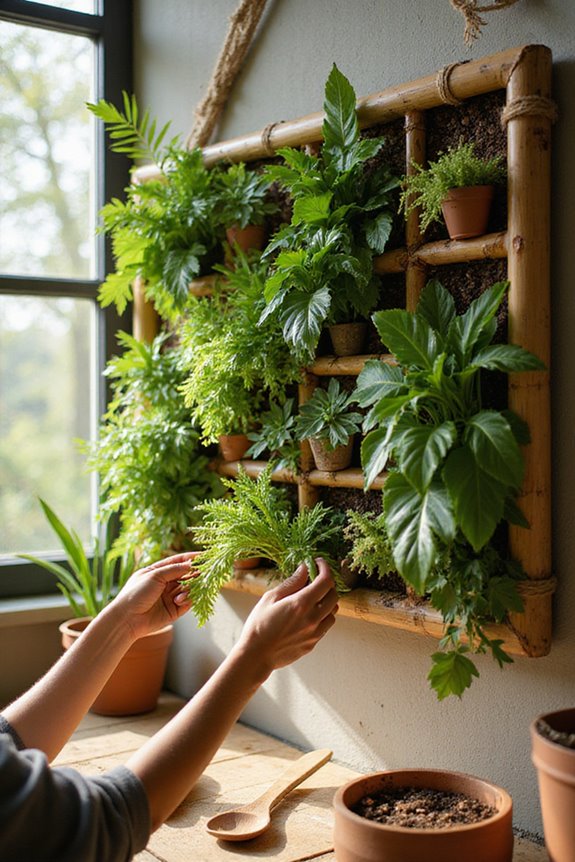To install a vertical garden, we should first select the right location that gets 6 to 8 hours of sunlight daily. Next, let’s choose suitable plants based on our climate; for example, succulents for hot areas or spinach for cooler environments. After that, we can build a sturdy structure using materials like wooden pallets. Finally, we’ll plant them thoughtfully, ensuring easy access for maintenance. Each step is essential for creating a thriving vertical garden, and there’s more to explore.
Key Takeaways
- Select a suitable location with 6 to 8 hours of sunlight and good drainage for your vertical garden installation.
- Choose plants that thrive in your climate and consider low-maintenance options for easier care.
- Build a sturdy structure using durable materials like wooden pallets or metal posts, ensuring proper assembly and alignment.
- Arrange plants by their sunlight needs and height for visual interest and accessibility during maintenance.
- Implement a drip irrigation system and regularly monitor soil moisture for optimal plant health.
Selecting the Right Location
Choosing the right location is essential for our vertical garden’s success. First, we need to contemplate sunlight exposure. Plants that love the sun typically need 6 to 8 hours of direct sunlight daily. For the best results, let’s look for south-facing walls, which provide ideal light in the Northern Hemisphere.
Next, we must also think about environmental protection. A sheltered spot can shield our plants from strong winds and cold drafts. We should avoid areas where heavy rain might pool, as this could damage our setup.
Lastly, let’s verify our chosen location has good drainage and easy access for maintenance. Additionally, we should consider using vertical garden containers that promote efficient drainage and moisture management for optimal plant health. By taking these factors into account, we can create a thriving vertical garden that we can all enjoy together.
Choosing Suitable Plants
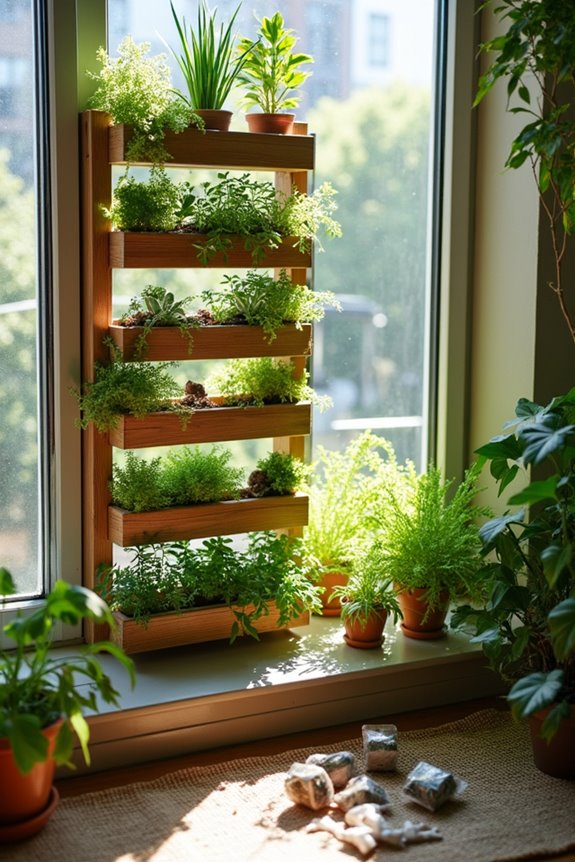
When we think about our vertical garden, selecting the right plants is essential to its success. To achieve this, we must consider climate suitability and plant selection. Here are some great options:
- For Hot Climates:
- Succulents and Aloe Vera thrive in sunny conditions.
- Cherry tomatoes are perfect for warmth.
- Spinach and peas are ideal choices.
- Lettuce also does well in cooler temperatures.
- Heuchera ‘Melting Fire’ and Carex morrowii are easy to care for.
- Tulbaghia violacea offers attractive blooms with minimal effort. Additionally, incorporating companion planting can enhance the overall health and productivity of your vertical garden.
Designing Your Vertical Garden Layout
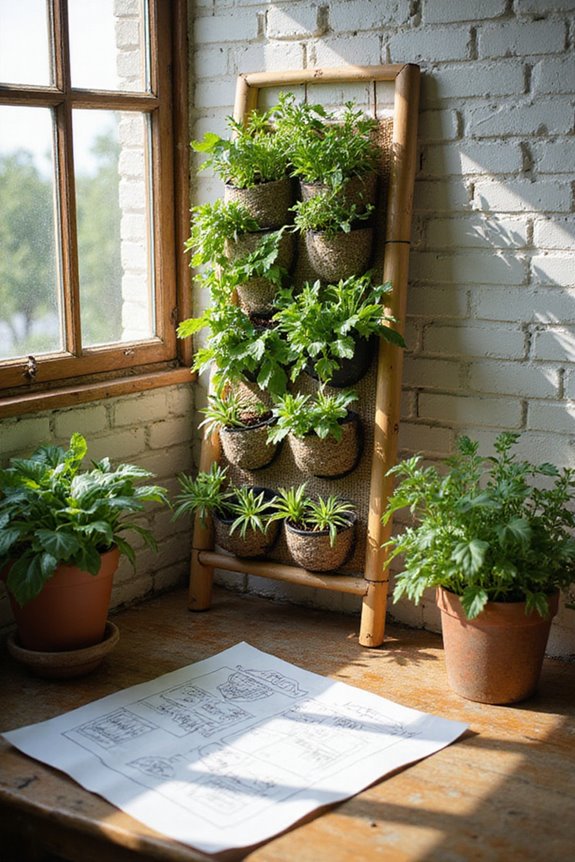
How can we create a visually appealing and functional layout for our vertical garden? First, we should consider design elements like varying plant heights and container types. This not only enhances visual interest but also optimizes our limited space. Next, let’s focus on color balance. By mixing plant colors and textures, we can create a harmonious look that draws the eye.
We also need to arrange plants according to their sunlight needs. For example, place sun-loving plants at the top and shade-tolerant ones below. Additionally, we should guarantee accessibility for easy maintenance. Finally, using modular systems or tiered planters can help us achieve depth and variety, making our vertical garden a beautiful focal point in our space. Incorporating vertical garden kits can provide an efficient and user-friendly solution for creating your ideal garden setup.
Building the Garden Structure
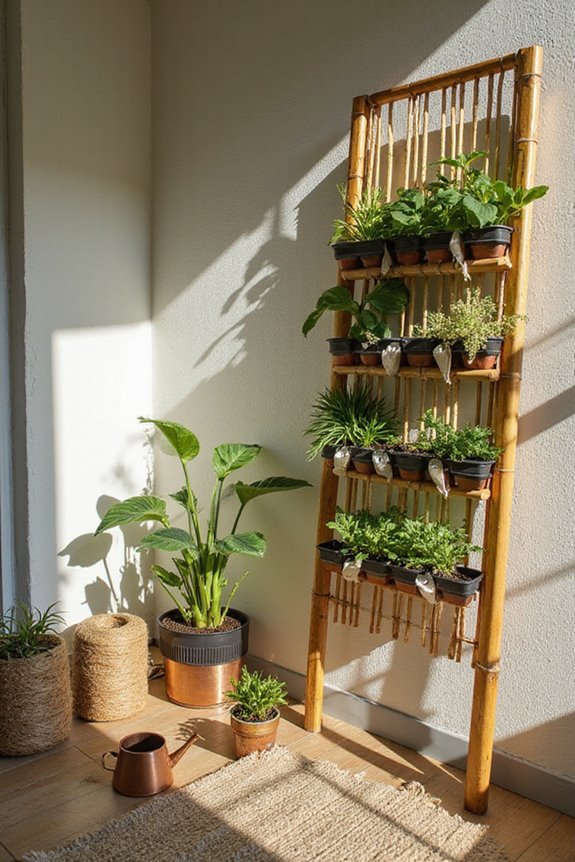
Building a sturdy structure is vital for our vertical garden. First, we need to focus on material selection. Common bases include wooden pallets, metal posts, or plywood. Wooden pallets should be sanded and sealed to prevent rot.
Next, let’s consider assembly techniques. Using 6×6 posts or 2×4 stringers offers strong support. We’ll align the posts with string lines to guarantee everything is level. For added stability, we can mount panels directly to walls using strong fasteners like VELCRO® Extreme Lock.
Finally, waterproofing is imperative. We can use landscape fabric and non-toxic sealants to protect our structure while retaining soil. Additionally, ensuring proper drainage features is essential to prevent waterlogging and promote healthy growth in our vertical garden. By carefully choosing materials and employing effective assembly techniques, we’ll create a lasting foundation for our vertical garden.
Selecting and Attaching Planters
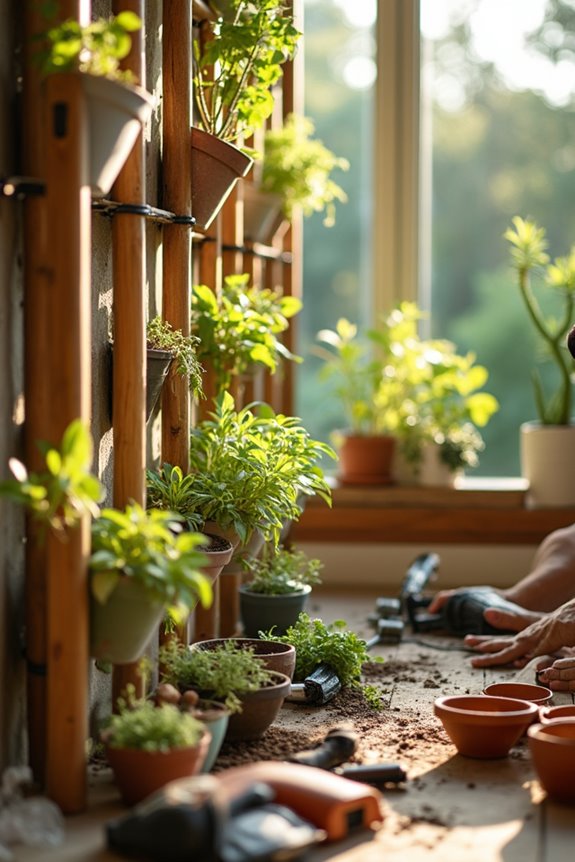
Selecting the right planters is essential for our vertical garden’s success. We can choose from various planter materials, including wooden boxes, lightweight plastic, or even fabric plant pockets. Each option has its benefits; for instance, wooden planters are customizable while plastic ones are easy to hang.
Next, we’ll consider attachment methods. Velcro® Brand Extreme Lock Fasteners are great for easy adjustments, while screws work well for sturdier materials. Wire grids can also support hanging planters effectively.
Planting Techniques and Arrangement
When creating a vertical garden, effective planting techniques and arrangement are essential for success. We should choose climbing or vining plants, like cucumbers and tomatoes, that thrive in confined spaces. Planting density matters; placing three plants per pocket maximizes growth while ensuring airflow to reduce disease risks.
To enhance our garden’s aesthetics, we can layer plants by height, allowing shorter ones to bask in sunlight. Using proper training techniques, we can guide plants onto trellises or stakes, securing them with thin twine for support. Additionally, considering hydroponic systems can further optimize plant growth and yield.
Remember to group plants with similar water needs to simplify care. By following these strategies, we’ll create a vibrant, healthy vertical garden that not only looks great but also serves our gardening goals.
Maintenance and Care for Your Vertical Garden
Maintaining and caring for our vertical garden is essential for its health and productivity. Here are some key practices to follow:
- Watering Techniques
- Use drip irrigation or micro-sprayers for even moisture.
- Monitor soil moisture levels regularly.
- Guarantee all plants, especially those at the top, receive adequate water.
- Inspect for pests like aphids and spider mites regularly.
- Use organic methods first to control infestations.
- Keep the area clean by removing plant debris.
- Regularly prune to encourage healthy growth and air circulation.
- Remove dead or diseased leaves promptly.
Enhancing Your Garden With Lighting and Climate Control
After we’ve covered the maintenance and care of our vertical garden, it’s time to focus on how we can enhance its overall health and aesthetics with lighting and climate control.
- Lighting Techniques
- Use LED lighting for energy efficiency and minimal heat.
- Guarantee even light distribution to prevent shadows.
- Consider full-spectrum LEDs to mimic sunlight.
- Maintain temperatures between 65°F and 75°F.
- Keep humidity levels between 40% and 60%.
- Implement air circulation to reduce fungal risks.
- Use timers for lighting cycles.
- Install sensors for light intensity and moisture.
Frequently Asked Questions
How Do I Prevent Pests in a Vertical Garden?
To prevent pests in our vertical garden, we can use organic solutions like companion planting and neem oil. By combining these pest control methods, we’ll create a thriving environment that benefits all our plants together.
Can I Use Recycled Materials for Planters?
They say one person’s trash is another’s treasure. We can definitely use recycled planters made from eco-friendly materials! Let’s embrace sustainability together and create a thriving garden while reducing waste in our community.
What Is the Best Way to Water Vertical Gardens?
When it comes to watering our vertical gardens, we’ve found drip irrigation and self-watering systems to be the best. They efficiently deliver water, ensuring our plants thrive while minimizing waste. Let’s keep our gardens flourishing together!
How Can I Winterize My Vertical Garden?
Winterizing our vertical garden may seem intimidating, but with proper winter preparation and frost protection techniques, we can guarantee our plants thrive. Let’s embrace this season together and keep our greenery flourishing through the cold months!
Are There Specific Plants That Thrive in Vertical Gardens?
When we think about plant selection for vertical gardens, we find that shallow-rooted veggies and vibrant herbs thrive under ideal conditions. Together, let’s explore these options to create our lush, vertical oasis!

